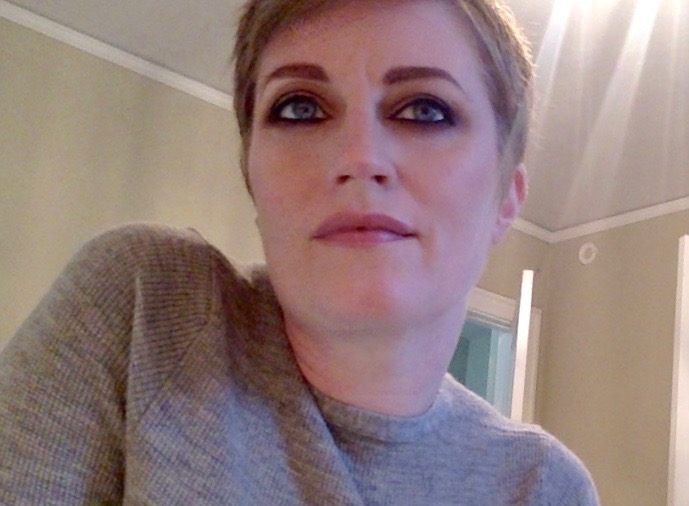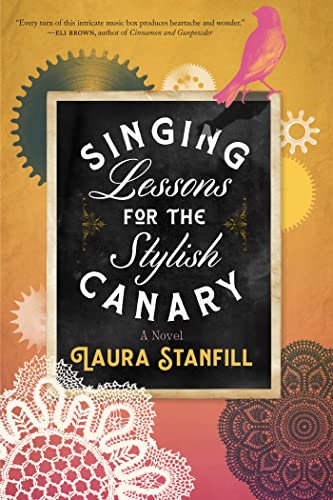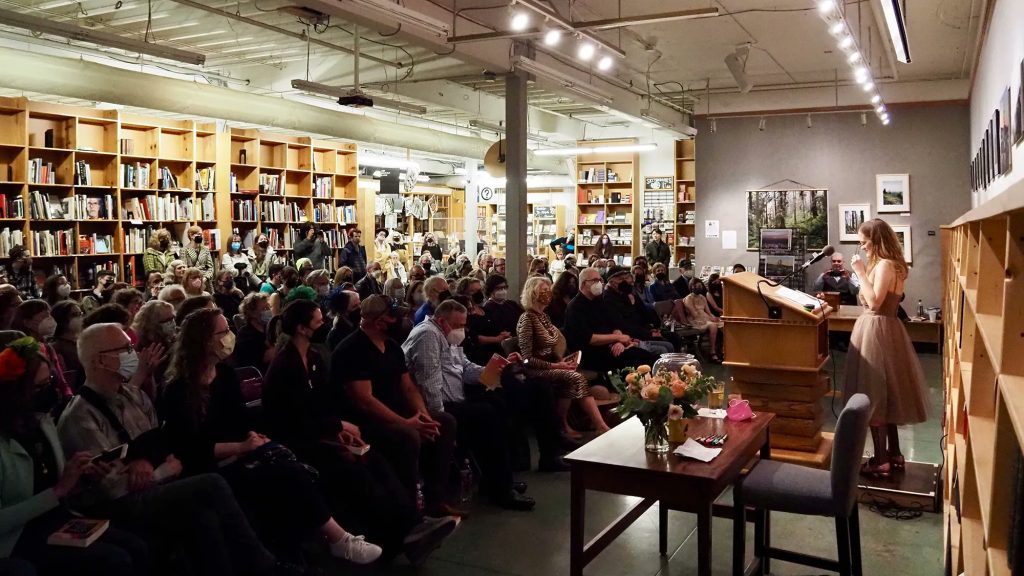Blog
Meet a Resident: Laura Stanfill
Mineral alums Grace Campbell (2018) and Laura Stanfill (2018) sat down to discuss the release of Laura’s debut novel, Singing Lessons For The Stylish Canary, which debuted during April 2022 from Lanternfish Press.

Laura (on the right!) is the founder of Forest Avenue Press, a literary publisher in Portland, Oregon. Her work has been featured in Catapult, The Rumpus, Shondaland and several print anthologies. She published the book Sad House during the pandemic. She lives in Portland with her family and a dog named Waffles.

Grace (on the left) is Fiction Editor at 5×5 Magazine. She’s been nominated for Best of The Net, a Pushcart Prize and featured in Best Small Fictions. You can find her work in Hobart, Brevity, Joyland, Midway and beyond.
You’ve spoken before on how this book was born after having a realization that you didn’t have to write the “serious novel.” Yet your book is so rich in pathos, touching on themes like loss, miscarriage, alienation. Talk about how you balanced that timbre of whimsy (a fairy-tale vibe) with these heavier themes. Is this is a frequency you’d like to continue in future works? Also I would love to hear about your process moving away from writing The Great Big Serious novel to this wonderful and unique work you’ve published.

I used to feel like I needed to write books that were the equivalent of wearing an all-purpose black cocktail dress — understated, elegant, possibly despairing. I wanted my work to be taken seriously as literature. But after two failed contemporary novels and acknowledging my neurodivergence, I’ve let myself become more playful on the page (and in my attire). My storytelling voice has always been more like a flowered jumpsuit or a skirt with crinoline; the nineteenth-century setting I created in Singing Lessons for the Stylish Canary is a much-better match for that kind of sound than, say, a modern-day newsroom.
In putting whimsy on the page, though, I still wanted my characters to experience big events so they’d feel real and multifaceted to readers. In other words, I didn’t want to evoke the playfulness without deeper meaning, undercurrents of grief and despair, actual life stakes. Maybe, to continue the clothing metaphor, this braid of major themes and fairy-tale sensibilities is like a fancy gown pinned to a clothesline. It moves in the wind. It’s a curiosity — beautiful, unexpected, but hopefully it also makes us wonder. Has this garment been forgotten or abandoned? What’s the story?
My next novel has a more urgent sound, with fewer fanciful elements, but I think it has a similar vibe. It’s set in the past and there’s a bit of magic and lots of music. It’s different in tone and texture, but it comes from a similar wellspring—and the one after that, which I’m just tiptoeing into, does too. I think I’ve found my way as a novelist.
Did the book, at its completion, end up being what you had set out to do? Or something different?
While the plot changed over the years — fifteen of them! — the story concept remained true. This is exactly what I wanted to do when I began. I had no idea how, but I wanted to create a big sound, with a village that has its own voice, and to explore themes of gender, voice, and friendship.
The journal Brevity is one among many who regularly posts bite-sized columns on writing advice and there’s a heft of books out there that offer this sort of assistance. Do you find yourself mining these resources or do you veer away from that sort of input? How do you feel the Writing Advice out there fits into the lived experiences of women?
I used to devour all the articles, all the books, every interview. I wanted to know how writers became. I wrote constantly, and wanted to have a book in the world, so reading advice helped me hone my craft but also narrow the gap between “just” writing and the possibility of publication. Once I gained some confidence, attending events at bookstores and I continued my education on both levels: the writing side and the publishing one.
A lot of the writers’ life books I read as a younger person totally don’t apply to my life now, as a mom of two children and a business owner. I revised Singing Lessons during the pandemic, with my kids on the couch next to me. It had to be done that way — and it wasn’t ideal for any of us. None of the standard guidelines applied. I’d add that there’s a lot of misguided advice out there about how women are supposed to tell a story, or what stories aren’t to be shared. That’s infuriating. I can’t tease apart what I read, what changed me or paused me, in my earlier years, but I’m sure I incorporated some of those toxic perspectives into my thinking and had to shed them.
If you could write a letter to your earlier self, the Laura who embarked on the journey to bring this story to life, what would you say?
You’ve mapped out way too much story for one novel. That’s what I’d say. I spent years on story chunks that ended up getting cut — hundreds of pages. I don’t mind how long it took, because all kinds of life milestones happened during my years of working on this book, and I don’t think I could have written something so layered if I had rushed it. I needed to grow into myself, not just as a writer but as a person. But it would have made the process easier on myself if I hadn’t imagined such an enormous arc and then tried to wrangle it into 80,000 words.
What cadre of works helped you keep your fingerprint on the tone of this? Meaning, not just literary work but art, music, visual pieces, cultural tidbits. What, around you, most found and wound its way through Singing Lessons?

I live very much outside popular culture, except for books, so I can’t cite any movies, TV shows, or contemporary music that influenced me. I’d say my childhood experience growing up with music boxes, and the sound of the mechanisms inside each box, is on every page of this novel. Same with Mahler; I didn’t put his compositions into the book, but the sound of his work astounded me when I first heard the Fourth Symphony. I related to it in a deeply emotional way and it made me think about music differently.
I’ve read so many novels over the years. Selden Edwards’s The Little Book helped me figure out I could mix history and magic. He encouraged me to go as far as I could with research and then make it up. I loved Jessie Burton’s The Miniaturist, again for the mix of history and magic, but it had a much bleaker, more severe tone than I wanted to achieve in my work. And I devoured The Signature of All Things by Elizabeth Gilbert when I was still struggling with how to write about the past with a modern eye.
For you, are retreats and residencies like Mineral School primarily generative? Or enclaves of respite where you can get a new vantage point on your story’s organization, technical issues and overall feel? A lot of writers suffer from burdening their residency time with too many expectations. How do you relate to this? How do you manage it?
Retreats are generative for me. I power through pages, getting story down, and often surprising myself with what pours out. I love revising and have absolutely used retreats to revise before, but usually having lots of quiet hours ahead means digging deeper, and seeing what I find, and not giving up too soon on an idea. As I recall, when we were at Mineral School together, I finished polishing a draft of Singing Lessons, one that was due to my agent, but then I dug into a new novel project and started several essays. I mapped the new novel out on the chalkboard in my room, thinking about how the characters would move through time and space.
That being said, I have grappled with my unhealthy relationship with productivity and am finally in a better place thanks to COVID. When my children were tiny and I had a week in the woods to write, I never took breaks. I wanted to keep going, stay focused, return to reality with a massive amount of material. Because then I’d feel the pressure of everyone else’s needs—the family, my business, the everyday routines, my volunteer work. But now that I’ve learned to work amid the chaos and tumble of everyday life, I am more inclined to take breaks, especially walks with my dog, to clear my head and think about the next scene.
Lately I’ve been doing research for my new book in the car at school pickup. I might only have ten minutes, but then I can carry what I’ve learned with me as I move through the rest of my day.

What is one true thing about the book that you realized had always been true? Were there realizations that worked forward and backward in time, and how did you greet and make use of these?
So much changed over the years. Henri used to have an older brother. He used to be supernaturally flexible. A whole host of characters lived in Five Points, New York, and I swept them away after realizing that the story really needed to circle back to the beginning, not keep growing, as life does. I guess that’s the constant: I wanted to put life on the page. Not my life, or a specific kind of realism, but the surprises and bumpiness. The messiness.
How did you know the book was done? I would love to hear about your editing process.
I didn’t really, truly know for a long time. Not like I did with my new book, which I wrote, then revised, and thought: there. With Singing Lessons for the Stylish Canary, I received a lot of positive, early feedback that I incorporated without thinking about what I wanted. Once I connected with my agent, Laurie Fox, she ushered me into a deeper, more focused period of revision that sharpened around what I had always wanted the book to be. Even then, I ended up holding on to an old ending for longer than I should have, based on an earlier idea of the arc.
Did you encounter growing pains with each character, where their likability faltered either through the writing process or because they wanted to become something you had not intended?
Some of my characters became more endearing, more understandable, the more I worked on them. Georges, Henri’s father, wants to build on his father’s legacy, and he’s upholding the strict social constructs that are harmful to the women around him. But he also revealed a gentler, more baffled side as I worked on him.
Editing Joanna Rose’s A Small Crowd of Strangers, and seeing how she put Michael on the page, helped me figure out how to let him grow into himself without minimizing his mistakes.
Were there discoveries you made when studying lace-making and serinette production that you stored away for use in other projects? How did learning about their history effect you as a person and writer?

There’s one little-known, flashy, historical figure I had to cut from the novel. Henri became obsessed with him, but the material didn’t really fit into the story. I’d love to pull an essay together about discovering this person, and how reading about his life influenced the making of this novel. Part of the enchantment, for me, was how this figure was written about — the grandiose tone a 1960s biographer took in describing him. The whole nonfiction book sounds like stories a grandparent might tell about the olden days, except they were reported as unwavering truth. It’s such a clear example of history being reimagined by a man with language skills and a publisher. Someone with power lifting up someone else with power.
As far as understanding history, I am still thinking about everyday life, the objects and expectations and rules, especially around gender. To create scenes set in the past, you have to research, identify, and imagine what a kitchen would look like, what food might be cooked and served, how preservation worked. I recently started rereading A Hundred Years of Solitude by Gabriel Garcia Marquez, a longtime favorite, and the passages about seeing ice for the first time felt even more magical than in previous re-readings, because I’ve invested so much time and thought in how it would be to live without refrigeration.
I’m still thinking about—and writing about—the history of music and life before radios, and when making beautiful objects with your hands was an everyday job, one that actually could earn a living for a family.
In Singing Lessons, the weather becomes a kind of character, adjunct to the host bodies of the human characters who are unwittingly tied to it. In keeping with a long tradition of imbuing the weather with magical qualities, how did you decide to fit this motif into your work and why?
I wanted to separate my fictional town, Mireville, from its real-world counterpart, Mirecourt, where serinettes were built. It would have been a hard life, making instruments for export, repeatedly making the same parts, then sending the beauty outside the community. And I didn’t want to write a book with a severe, even unhappy, tone, so adding magic was one way to lighten the story and lift it away from the actual historical facts.
Also, I loved the idea of having a male firstborn baby get credit for changing the weather. It seems so random and yet why wouldn’t this village believe the son of a prestigious craftsman would have that kind of power?
What kind of practice benefitted you the most?
Stepping outside the novel, years into the writing, and working on personal essays. What I unpacked in my nonfiction helped me understand what I had been trying to say in fiction. The arc sharpened around insights about my life and neurodivergence.
In what ways will the story of Singing Lessons, and the story of having written it, inform you, going forward?
I’ve worked toward having a debut novel my whole life, so the achievement means… what? Adjusting my goals, I guess, from the first one to the next ones. I have three projects in the works now — a finished manuscript, a proposal for a nonfiction book, and a new novel idea. On the publishing side, right now I’m focused on the idea of success — what it means in publishing and how not to subvert the joy of achievement by measuring sales or media coverage with false or unrealistic metrics.





